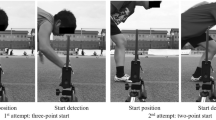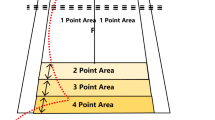Abstract
The relationship between balance ability and sport injury risk has been established in many cases, but the relationship between balance ability and athletic performance is less clear. This review compares the balance ability of athletes from different sports, determines if there is a difference in balance ability of athletes at different levels of competition within the same sport, determines the relationship of balance ability with performance measures and examines the influence of balance training on sport performance or motor skills.
Based on the available data from cross-sectional studies, gymnasts tended to have the best balance ability, followed by soccer players, swimmers, active control subjects and then basketball players. Surprisingly, no studies were found that compared the balance ability of rifle shooters with other athletes. There were some sports, such as rifle shooting, soccer and golf, where elite athletes were found to have superior balance ability compared with their less proficient counterparts, but this was not found to be the case for alpine skiing, surfing and judo. Balance ability was shown to be significantly related to rifle shooting accuracy, archery shooting accuracy, ice hockey maximum skating speed and simulated luge start speed, but not for baseball pitching accuracy or snowboarding ranking points. Prospective studies have shown that the addition of a balance training component to the activities of recreationally active subjects or physical education students has resulted in improvements in vertical jump, agility, shuttle run and downhill slalom skiing. A proposed mechanism for the enhancement in motor skills from balance training is an increase in the rate of force development. There are limited data on the influence of balance training on motor skills of elite athletes. When the effectiveness of balance training was compared with resistance training, it was found that resistance training produced superior performance results for jump height and sprint time.
Balance ability was related to competition level for some sports, with the more proficient athletes displaying greater balance ability. There were significant relationships between balance ability and a number of performance measures. Evidence from prospective studies supports the notion that balance training can be a worthwhile adjunct to the usual training of non-elite athletes to enhance certain motor skills, but not in place of other conditioning such as resistance training. More research is required to determine the influence of balance training on the motor skills of elite athletes.





Similar content being viewed by others
References
Nashner LM. Practical biomechanics and physiology of balance. In: Jacobson GP, Newman CW, Kartush JM, editors. Handbook of balance function testing. San Diego(CA): Singular Publishing Group, 1997: 261–79
Hrysomallis C. Relationship between balance ability, training and sports injury risk. Sports Med 2007; 37 (6): 547–56
Winter DA, Patla AE, Frank JS. Assessment of balance control in humans. Med Prog Technol 1990; 16 (1-2): 31–51
Kioumourtzoglou E, Derri V, Mertzanidou O, et al. Experience with perceptual and motor skills in rhythmic gymnasts. Percept Mot Skills 1997; 84 (3): 1363–72
Paillard T, Noe F. Effect of expertise and visual contribution on postural control in soccer. Scand JMed Sci Sports 2006; 16 (5): 345–8
Wells GD, Elmi M, Thomas S. Physiological correlates of golf. J Strength Cond Res 2009; 23 (3): 741–50
Aalto H, Pyykko I, Ilmarinen R, et al. Postural stability in shooters. Otol Rhinol Laryngol 1990; 52 (4): 232–8
Paillard T, Costes-Salon C, Lafont C, et al. Are there differences in postural regulation according to the level ofcompetition in judoists? Br J Sports Med 2002; 36 (4): 304–5
Asseman F, Caron O, Cremieux J. Are there specific conditions which expertise in gymnastics could have an effect onpostural control and performance? Gait Posture 2008; 27 (1): 76–81
Winter DA. ABC (anatomy, biomechanics and control) of balance during standing and walking. Waterloo (ON): Waterloo Biomechanics, 1995
Clark RA, Bryant AL, Pau Y, et al. Validity and reliability of the Nintendo Wii Balance Board for assessment ofstanding balance. Gait Posture 2010; 31 (3): 307–10
Kean CO, Behm DG, Young WB. Fixed foot balance training increases rectus femoris activation during landing andjump height in recreationally active women. J Sports Sci Med 2006; 5 (1): 138–48
Bressel E, Yonker JC, Kras J, et al. Comparison of static and dynamic balance in female collegiate soccer, basketball,and gymnastics athletes. J Athl Train 2007; 42 (1): 42–6
Thorpe JL, Ebersole KT. Unilateral balance performance in female collegiate soccer athletes. J Strength Cond Res 2008; 22 (5): 1429–33
Davlin CD. Dynamic balance in high level athletes. Percept Mot Skills 2004; 98 (3): 1171–6
Malliou P, Amoutzas K, Theodosiou A, et al. Proprioceptive training for learning downhill skiing. Percept Mot Skills 2004; 99 (1): 149–54
Platzer H-P, Raschner C, Patterson C. Performancedetermining physiological factors in the luge start. J Sports Sci 2009; 27 (3): 221–6
Yaggie JA, Campbell BM. Effects of balance training on selected skills. J Strength Cond Res 2006; 20 (2): 422–8
Paillard T, Noe F, Riviere T, et al. Postural performance and strategy in the unipedal stance of soccer players at differentlevels of competition. J Ath Train 2006; 41 (2): 172–6
Riemann BL, Guskiewicz KM, Shields EW. Relationship between clinical and forceplate measures of postural stability. J Sport Rehabil 1999; 8 (2): 71–82
Vuillerme N, Danion F, Marin L, et al. The effect of expertise in gymnastics on postural control. Neurosci Lett 2001; 303 (2): 83–6
Aydin T, Yildiz Y, Yildiz C, et al. Proprioception of the ankle: a comparison between female teenaged gymnastsand controls. Foot Ankle Int 2002; 23 (2): 123–9
Carrick FR, Oggero E, Pagnacco G, et al. Posturographic testing and motor learning predictability in gymnasts. Disabil Rehabil 2007; 29 (24): 1881–9
Calavalle AR, Sisti D, Rocchi MBL, et al. Postural trials: expertise in rhythmic gymnastics increases control in lateraldirection. Eur J Appl Physiol 2008; 104 (4): 643–9
Kioumourtzoglou E, Derri V, Tzetzis G, et al. Cognitive perceptual, and motor abilities in skilled basketball performance. Percept Mot Skills 1998; 86 (3): 771–86
Perrin P, Deviterne D, Hugel F, et al. Judo, better than dance, develops sensorimotor adaptabilities involved inbalance control. Gait Posture 2002; 15 (2): 187–94
Schmit JM, Regis DI, Riley MA. Dynamic patterns of postural sway in ballet dancers and track athletes. Exp Brain Res 2005; 163 (3): 370–8
Gerbino PG, Griffin ED, Zurakowski D. Comparison of standing balance between female collegiate dancers andsoccer players. Gait Posture 2007; 26 (4): 501–7
Matsuda S, Demura S, Uchiyama M. Centre of pressure sway characteristics during static one-legged stance ofathletes from different sports. J Sports Sci 2008; 26 (7): 775–9
Niinimaa V, McAvoy T. Influence of exercise on body sway in standing rifle shooting. Can J Appl Sport Sci 1983; 8 (1): 30–3
Era P, Konttinen P, Mehto P, et al. Postural stability and skilled performance: a study on top-level and naive rifleshooters. J Biomech 1996; 29 (3): 301–6
Konttinen N, Lyytinen H, Era P. Brain slow potentials and postural sway behaviour during sharpshooting performance. J Mot Behav 1999; 31 (1): 11–20
Noe F, Paillard T. Is postural control affected by expertise in alpine skiing? Br J Sports Med 2005; 39: 835–7
Sell TC, Tsai Y-S, Smoliga JM, et al. Strength, flexibility, and balance characteristics of highly proficient golfers. J Strength Cond Res 2007; 21 (4): 1166–71
Chapman DW, Needham KJ, Allison GT, et al. Effect of experience in a dynamic environment on postural control. Br J Sports Med 2008; 42 (1): 16–21
Mason BR, Pelgrim PP. Body stability and performance in archery. Excel 1986; 3 (2): 17–20
Ball KA, Best RJ, Wrigley TV. Body sway, aim point fluctuation and performance in rifle shooters: inter- and intraindividualanalysis. J Sports Sci 2003; 21 (7): 559–66
Marsh DW, Richard LA, Williams LA, et al. The relationship between balance and pitching error in college baseballpitchers. J Strength Cond Res 2004; 18 (3): 441–6
Behm DG, Wahl MJ, Button DC, et al. Relationship between hockey skating speed and selected performancemeasures. J Strength Cond Res 2005; 19 (2): 326–31
Mononen K, Konttinen N, Viitasalo J. Relationship between postural balance, rifle stability and shooting accuracyamong novice rifle shooters. Scand J Med Sci Sports 2007; 17 (2): 180–5
Platzer H-P, Raschner C, Patterson C, et al. Comparison of physical characteristics and performance among elitesnowboarders. J Strength Cond Res 2009; 23 (5): 1427–32
Hrysomallis C, Buttifant D, Buckley N. Weight training for Australian football. Melbourne (VIC): Lothian Books, 2006: 105–9
Bruhn S, Kullmann N, Gollhofer A. The effects of a sensorimotor training and a strength training on posturalstabilisation, maximum isometric contraction and jumpperformance. Int J Sports Med 2004; 25 (1): 56–60
Cressey EM, West CA, Tiberio DP, et al. The effects of ten weeks of lower-body unstable surface training on markersof athletic performance. J Strength Cond Res 2007; 21 (2): 561–7
Lephart SM, Smoliga JM, Myers JB, et al. An eight-week golf specific exercise program improves physical characteristics,swing mechanics, and golf performance in recreactionalgolfers. J Strength Cond Res 2007; 21 (3): 860–9
Simek Salaj S, Milanovic D, Jukic I. The effects of proprioceptive training on jumping and agility performance. Kinesiol 2007; 39 (2): 131–41
Ashton-Miller JA, Wojtys EM, Huston LJ, et al. Can proprioception really be improved by exercises? Knee Surg Sports Traumatol Arthrosc 2001; 9 (3): 128–36
Taube W, Gruber M, Gollhofer A. Spinal and supraspinal adaptations associated with balance training and theirfunctional relevance. Acta Physiol 2008; 193 (2): 101–16
Lloyd D. Rationale for training programs to reduce anterior cruciate ligament injuries in Australian football. J Orthop Sports Phys Ther 2001; 31 (11): 645–54
Heitkamp H-C, Horstmann T, Mayer F, et al. Gain in strength and muscular balance after balance training. Int J Sports Med 2001; 22 (4): 285–90
Holm I, Fosdahl MA, Friis A, et al. Effect of neuromuscular training on proprioception, balance, muscle strength, andlower limb function in female team handball players. Clin J Sport Med 2004; 14 (2): 88–94
Gruber M, Gollhofer A. Impact of sensorimotor training on the rate of force development and neural activation. Eur J Appl Physiol 2004; 92 (1-2): 98–105
Gruber M, Gruber SBH, Gruber SBH, et al. Differential effects of ballistic versus sensorimotor training on rate of forcedevelopment and neural activation in humans. J StrengthCond Res 2007; 21 (1): 274–82
Vuillerme N, Teasdale N, Nougier V. The effect of expertise in gymnastics on proprioceptive sensory integration inhuman subjects. Neurosci Lett 2001; 311 (2): 73–6
Paillard T, Bizid R, Dupui P. Do sensorial manipulations affect subjects differently depending on their posturalabilities. Br J Sports Med 2007; 41 (7): 435–8
Acknowledgements
The author has no conflicts of interest that are directly relevant to the content of this review. No sources of funding were used to assist in the preparation of this review.
Author information
Authors and Affiliations
Corresponding author
Rights and permissions
About this article
Cite this article
Hrysomallis, C. Balance Ability and Athletic Performance. Sports Med 41, 221–232 (2011). https://doi.org/10.2165/11538560-000000000-00000
Published:
Issue Date:
DOI: https://doi.org/10.2165/11538560-000000000-00000




